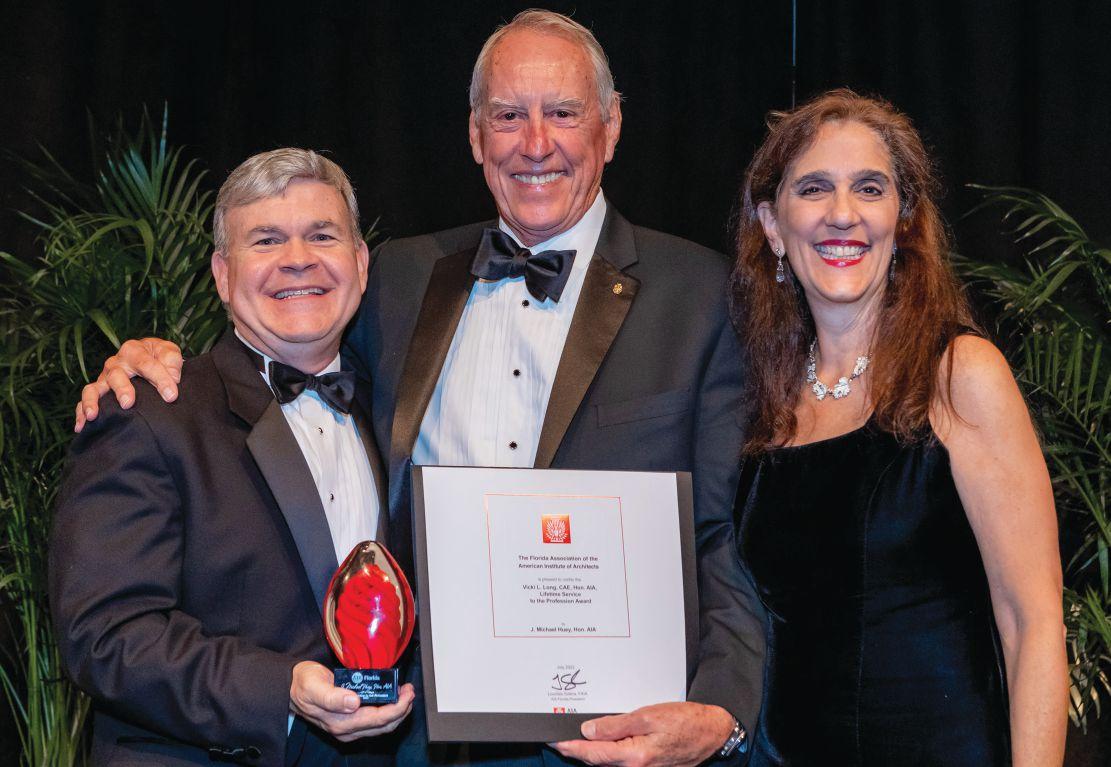
2 minute read
University of Florida College of Design, Construction and Planning
from AIA Florida
Gainesville, Florida
Brooks + Scarpa and KMF Architecture
Fort Lauderdale and Orlando, Florida
Eric Kleinsteuber, AIA, was in architecture school with Jeffrey Huber, FAIA, when he proposed covering the open atrium of the University of Florida College of Design, Construction and Planning with a layer of cling wrap for a project.
When the pair was able to do it in real life, Kleinsteuber was not too far from a complete solution to the problems that plagued the building since its construction in 1979.
“The building always leaked,” Huber said, owing to original plans for a covered atrium that were value engineered out of the project. More than 40 years of water intrusion wreaked havoc on the glazing, concrete and roof of the building, all of which needed to be replaced.

“The atrium is an iconic element,” Huber said. “It is literally the church for architects.”
Even though generations of students loved seeing the sky and having it open, it could not stay that way. The design team was asked to avoid putting in a canopy, but it soon became apparent that the systems that needed to be remodeled to keep the building as-is would be enormously expensive versus the cost of installing a canopy.
“We decided to figuratively kill 1,000 birds with one big bubble,” Kleinsteuber said.
This does not mean people liked it. Both said the blowback was quick and it was painful. Both firms had to work to not only find a design solution, but also get community buy-in to turn “not in my backyard” into “yes in my backyard.”



The solution was more elegant than cling wrap. The firms chose ETFE, ethylene tetrafluoroethylene, a fluorine-based plastic that is lightweight and was originally formulated to serve as a coating in the aerospace industry. It resists dust and dirt from sticking to it and can also be printed with patterns and layered to control sunlight. ETFE has since been used in several stadium projects and, now, at the University of Florida.
Structurally speaking, Huber said, the ETFE canopy is the same weight as the original hard canopy the building was designed to bear. But it has the added bonus of letting the sky and sunlight filter in.

“This is the most transparent you were going to get,” Huber added. It also offers passive ventilation and, when it rains, a unique sound that activates and adds drama to the atrium.
Where COVID-19 hobbled many architecture projects, for Huber and Kleinsteuber, the empty campus was a boon. It allowed the contractors to be more aggressive in their schedules and, when students and faculty returned, they were surprisingly pleased with the atrium’s new look.
“That was the most validating, getting messages from the faculty, the dean and the students,” Huber said. Now, with the protection from the elements, he said the atrium is being used more than it initially was – and that was a lot. Classes, exhibitions, speeches and more are being hosted in the space.
Most recently, the college showed off the new atrium as part of a groundbreaking ceremony for the $32 million Bruno E. and Maritza F. Ramos Collaboratory Building, another partnership between Brooks + Scarpa and KMF, that will add nearly 50,000 square feet to the existing College of Design, Construction and Planning building.
The Collaboratory will include multifunctional spaces for students, faculty and staff to collaborate on projects; research hubs for all of the college’s research centers and institutes; a digital modeling and fabrication space; facilities for geospatial modeling and simulation; a virtual reality lab; and a multipurpose hall and seminar rooms for large lecture audiences.
“This innovative facility is critical to the future of the College of Design, Construction and Planning and will strengthen collaborative working across all the built environment disciplines in the college,” said Dean Chimay Anumba. “It will position the college well for its next phase following our centennial in 2025. We are most grateful for the tremendous financial and in-kind support of our alumni and friends, which has made this possible.”












